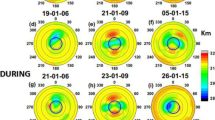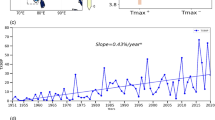Abstract
Previous studies suggest that the atmospheric precursor of El Niño-Southern Oscillation (ENSO) in the extratropical Southern Hemisphere (SH) might trigger a quadrapole sea surface temperature anomaly (SSTA) in the South Pacific and subsequently influence the following ENSO. Such a quadrapole SSTA is referred to as the South Pacific quadrapole (SPQ). The present study investigated the relationships between the atmospheric precursor signal of ENSO and leading modes of atmospheric variability in the extratropical SH [including the SH annular mode (SAM), the first Pacific-South America (PSA1) mode, and the second Pacific-South America (PSA2) mode]. The results showed that the atmospheric precursor signal in the extratropical SH basically exhibits a barotropic wavenumber-3 structure over the South Pacific and is significantly correlated with the SAM and the PSA2 mode during austral summer. Nevertheless, only the PSA2 mode was found to be a precursor for the following ENSO. It leads the SPQ-like SSTA by around one month, while the SAM and the PSA1 mode do not show any obvious linkage with either ENSO or the SPQ. This suggests that the PSA2 mode may provide a bridge between the preceding circulation anomalies over the extratropical SH and the following ENSO through the SPQ-like SSTA.
Similar content being viewed by others
References
Alexander, M. A., D. J. Vimont, P. Chang, and J. D. Scott, 2010: The impact of extratropical atmospheric variability on ENSO: Testing the seasonal footprinting mechanism using coupled model experiments. J. Climate, 23, 2885–2901.
Anderson, B. T., R. C. Perez, and A. Karspeck, 2013: Triggering of El Niño onset through trade wind-induced charging of the equatorial Pacific. Geophys. Res. Lett., 40, 1212–1216, doi: 10.1002/grl.50200.
Boschat, G., P. Terray, and S. Masson, 2013: Extratropical forcing of ENSO. Geophys. Res. Lett., 40(8), 1605–1611.
Bretherton, C. S., C. Smith, and J. M. Wallace, 1992: An intercomparison of methods for finding coupled patterns in climate data. J. Climate, 5, 541–560.
Compo, G. P., and P. D. Sardeshmukh, 2004: Storm track predictability on seasonal and decadal scales. J. Climate, 17, 3701–3720.
Deser, C., M. A. Alexander, S. P. Xie, and A. S. Phillips, 2010: Sea surface temperature variability: Patterns and mechanisms. Annual Review of Marine Science, 2, 115–143.
DeWeaver, E., and S. Nigam, 2004: On the forcing of ENSO teleconnections by anomalous heating and cooling. J. Climate, 17, 3225–3235.
Ding, H., R. J. Greatbatch, and G. Gollan, 2015c: Tropical impact on the interannual variability and long-term trend of the Southern Annular Mode during austral summer from 1960/1961 to 2001/2002. Climate Dyn., 44, 2215–2258.
Ding, H., R. J. Greatbatch, H. Lin, F. Hansen, G. Gollan, and T. Jung, 2016: Austral winter external and internal atmospheric variability between 1980 and 2014. Geophys. Res. Lett., 43, 2234–2239, doi: 10.1002/2016GL067862.
Ding, Q. H., E. J. Steig, D. S. Battisti, and J. M. Wallace, 2012: Influence of the tropics on the Southern Annular Mode. J. Climate, 25(18), 6330–6348.
Ding, R. Q., J. P. Li, Y. H. Tseng, C. Sun, and Y. P. Guo, 2015a: The Victoria mode in the North Pacific linking extratropical sea level pressure variations to ENSO. J. Geophys. Res., 120, 27–45, doi: 10.1002/2014JD022221.
Ding, R. Q., J. P. Li, and Y. H. Tseng, 2015b: The impact of South Pacific extratropical forcing on ENSO and comparisons with the North Pacific. Climate Dyn., 44, 2017–2034.
Gong, D. Y., and S. W. Wang, 1999: Definition of Antarctic oscillation index. Geophys. Res. Lett., 26, 459–462, doi: 10.1029/1999GL900003.
Jin, D., and B. P. Kirtman, 2009: Why the Southern Hemisphere ENSO responses lead ENSO. J. Geophys. Res., 114, D23101.
Jin, F. F., 1997a: An equatorial ocean recharge paradigm for ENSO. Part I: Conceptual model. J. Atmos. Sci., 54, 811–829.
Jin, F. F., 1997b: An equatorial ocean recharge paradigm for ENSO. Part II: A stripped-down coupled model. J. Atmos. Sci., 54, 830–847.
Kalnay, E., and Coauthors, 1996: The NCEP/NCAR 40-year reanalysis project. Bull. Amer. Meteor. Soc., 77, 437–471.
Karoly, D. J., 1989: Southern Hemisphere circulation features associated with El Niño-Southern Oscillation events. J. Climate, 2, 1239–1252.
Kidson, J. W., and J. A. Renwick, 2002: The southern hemisphere evolution of ENSO during 1981–99. J. Climate, 15, 847–863.
Kwok, R., and J. C. Comiso, 2002: Southern Ocean climate and sea ice anomalies associated with the Southern Oscillation. J. Climate, 15, 487–501.
L’Heureux, M. L., and D. W. J. Thompson, 2006: Observed relationships between the El Niño-Southern Oscillation and the extratropical zonal-mean circulation. J. Climate, 19, 276–287.
McPhaden, M. J., S. E. Zebiak, and M. H. Glantz, 2006: ENSO as an integrating concept in earth science. Science, 314, 1740–1745.
Mo, K. C., 2000: Relationships between low-frequency variability in the Southern Hemisphere and sea surface temperature anomalies. J. Climate, 13, 3599–3610.
Mo, K. C., and M. Ghil, 1987: Statistics and dynamics of persistent anomalies. J. Atmos. Sci., 44, 877–901.
Mo, K. C., and J. N. Paegle, 2001: The Pacific-South American modes and their downstream effects. International Journal of Climatology, 21(10), 1211–1229.
Newman, M., G. P. Compo, and M. A. Alexander, 2003: ENSO-forced variability of the Pacific decadal oscillation. J. Climate, 16, 3853–3857.
Rayner, N. A., P. Brohan, D. E. Parker, C. K. Folland, J. J. Kennedy, M. Vanicek, T. J. Ansell, and S. F. B. Tett, 2006: Improved analyses of changes and uncertainties in sea surface temperature measured in situ since the mid-nineteenth century: The HadSST2 dataset. J. Climate, 19, 446–469.
Rogers, J. C., 1981: The North Pacific oscillation. J. Climatol., 1, 39–57.
Schneider, N., and B. Cornuelle, 2005: The forcing of the Pacific decadal oscillation. J. Climate, 18, 4355–4373.
Seager, R., N. Harnik, Y. Kushnir, W. Robinson, and J. Miller, 2003: Mechanisms of hemispherically symmetric climate variability. J. Climate, 16, 2960–2978.
Straus, D. M., and J. Shukla, 2002: Does ENSO force the PNA. J. Climate, 15, 2340–2358.
Thompson, D. W. J., and J. M. Wallace, 2000: Annular modes in the extratropical circulation. Part I: Month-to-month variability. J. Climate, 13, 1000–1016.
Vimont, D. J., D. S. Battisti, and A. C. Hirst, 2003b: The seasonal footprinting mechanism in the CSIRO general circulation models. J. Climate, 16, 2653–2667.
Vimont, D. J., J. M. Wallace, and D. S. Battisti, 2003a: The seasonal footprinting mechanism in the Pacific: Implications for ENSO. J. Climate, 16, 2668–2675.
Walker, G. T., and E. W. Bliss, 1932: World weather V. Memoirs of the Royal Meteorological Society, 4, 53–84.
Yu, J. Y., and S. T. Kim, 2011: Relationships between extratropical sea level pressure variations and the central Pacific and eastern Pacific types of ENSO. J. Climate, 24, 708–720.
Yuan, X. J., 2004: ENSO-related impacts on Antarctic sea ice: A synthesis of phenomenon and mechanisms. Antarctic Science, 16, 415–425.
Acknowledgements
This research was jointly supported by the China Special Fund for Meteorological Research in the Public Interest (Grant No. GYHY201506013), the 973 project of China (Grant No. 2012CB955200), the National Natural Science Foundation of China for Excellent Young Scholars (Grant No. 41522502), the Strategic Priority Research Program of the Chinese Academy of Sciences (Grant No. XDA11010303), and the National Natural Science Foundation of China (Grant Nos. 41575075, 91437216 and 91637312).
Author information
Authors and Affiliations
Corresponding author
Rights and permissions
About this article
Cite this article
Qin, J., Ding, R., Wu, Z. et al. Relationships between the extratropical ENSO precursor and leading modes of atmospheric variability in the Southern Hemisphere. Adv. Atmos. Sci. 34, 360–370 (2017). https://doi.org/10.1007/s00376-016-6016-z
Received:
Revised:
Accepted:
Published:
Issue Date:
DOI: https://doi.org/10.1007/s00376-016-6016-z




